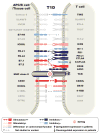Co-stimulatory and Co-inhibitory Pathways in Autoimmunity
- PMID: 27192568
- PMCID: PMC4873959
- DOI: 10.1016/j.immuni.2016.04.017
Co-stimulatory and Co-inhibitory Pathways in Autoimmunity
Abstract
The immune system is guided by a series of checks and balances, a major component of which is a large array of co-stimulatory and co-inhibitory pathways that modulate the host response. Although co-stimulation is essential for boosting and shaping the initial response following signaling through the antigen receptor, inhibitory pathways are also critical for modulating the immune response. Excessive co-stimulation and/or insufficient co-inhibition can lead to a breakdown of self-tolerance and thus to autoimmunity. In this review, we will focus on the role of co-stimulatory and co-inhibitory pathways in two systemic (systemic lupus erythematosus and rheumatoid arthritis) and two organ-specific (multiple sclerosis and type 1 diabetes) emblematic autoimmune diseases. We will also discuss how mechanistic analysis of these pathways has led to the identification of potential therapeutic targets and initiation of clinical trials for autoimmune diseases, as well as outline some of the challenges that lie ahead.
Copyright © 2016 Elsevier Inc. All rights reserved.
Figures




References
-
- Amrani A, Serra P, Yamanouchi J, Han B, Thiessen S, Verdaguer J, Santamaria P. CD154-dependent priming of diabetogenic CD4(+) T cells dissociated from activation of antigen-presenting cells. Immunity. 2002;16:719–732. - PubMed
-
- Ansari MJ, Fiorina P, Dada S, Guleria I, Ueno T, Yuan X, Trikudanathan S, Smith RN, Freeman G, Sayegh MH. Role of ICOS pathway in autoimmune and alloimmune responses in NOD mice. Clin Immunol. 2008;126:140–147. - PubMed
-
- Araki M, Chung D, Liu S, Rainbow DB, Chamberlain G, Garner V, Hunter KM, Vijayakrishnan L, Peterson LB, Oukka M, et al. Genetic evidence that the differential expression of the ligand-independent isoform of CTLA-4 is the molecular basis of the Idd5.1 type 1 diabetes region in nonobese diabetic mice. J Immunol. 2009;183:5146–5157. - PMC - PubMed

